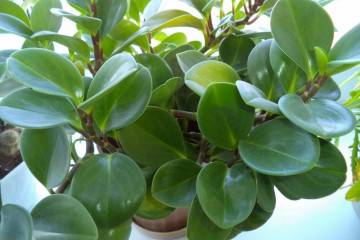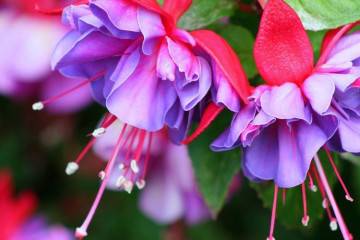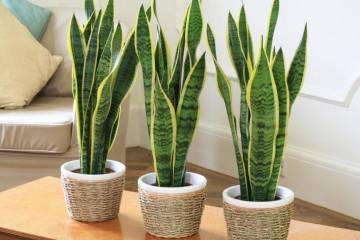Tillandsia atmospheric - home care
Content:
Tillandsia atmospheric - home exotic. This flower is able to decorate any room, so tillandsia in the interior looks much better than many others.
What does it look like, which family it belongs to
Tillandsia are epiphytes, that is, in their natural environment they grow and develop on tree trunks. Nevertheless, they cannot be attributed to parasites, the neighbors of the vines are used only as support.
Tillandsia is a plant without roots, its leaves are dense, gray in color. The average length of each does not exceed 25 cm. Their width is 10 mm.
Briefly about the history of appearance
The name for the Tillandsia atmospheric flower was invented by Carl Linnaeus. Studying the flower, he noticed that its leaves consist of scales tightly attached to each other. He regarded this fact as a sign of fear of excessive moisture.
As a student, he traveled from Stockholm to Turku by sea. The distance of 300 km was not easy for the Finnish botanist - all the way he suffered from seasickness. He has already paved the way back to Stockholm along the coastline of the Botanical Bay. It was 2000 km. Upon returning home, he changed his surname to Tillands, which means overland.
Homeland of the plant
Aerial Tillandsia comes from the Bromeliad family. The homeland of the flower is the central and southern part of America. Under natural conditions, there are more than 500 varieties, however, only a few dozen species have succumbed to domestication and cultivation at home.
Care features
If you take care of the flower correctly, it will delight you with its appearance for a long time. Caring for atmospheric tillandsia at home is quite simple.
Temperature
Atmospheric tillandsias do not tolerate heat. The ideal daytime temperature does not exceed 25 degrees. A decrease at night is allowed up to 15 degrees. In winter, the optimal temperature regime for them ranges from 14 to 18 degrees in the daytime and not less than 12 degrees at night.
Lighting
Atmospheric tillandsias love shaded areas. However, in natural conditions, they grow well under the hot tropical sun. When choosing a place for a house, it is recommended to give preference to places near the east or northwest windows. Here they will catch the rays of the rising sun or sunset. The daylight hours of a flower lasts 14 hours. It is necessary to take this into account in winter and purchase a phytolamp.
Watering
The flower is usually not watered. The procedure is completely replaced by spraying. In summer and during the heating season, the flower is dipped in a container of water for 2-3 hours. If the room is cold, the procedure is not carried out. If the leaves begin to curl, this is a clear sign of dehydration. The plant needs to be placed in a bath.
Spraying
In summer, the flower is sprayed 2-4 times a day. When the room temperature drops, the frequency of humidification is reduced. The water should be kept warm.
Humidity
Indoor humidity is the key to active growth and development of a flower.Like all epiphytes, tillandsia feeds on leaves. To prevent drying out, it is necessary to maintain a humidity level of 75%.
In an apartment it is not always possible to achieve such a value. Therefore, many growers purchase florariums or transfer the flower to the bathroom.
Priming
Tillandsia without roots. No soil is needed for flower growth. In the store, they are sold on stones, in shells or pieces of tree bark. Having brought the plant home, it is recommended to immediately decide where to place it. Frequent site changes and bandaging have a negative effect on delicate stems.
When choosing a support for a flower, it is necessary to take into account that you will need to bathe the flower in water with it. Experienced flower growers recommend placing the plant on a block that can be easily removed from the composition. Some use soft wire or nylon thread.
It is permissible to use sphagnum moss, which will serve as an additional feed. If you plan to fix tillandsia on stones, then you must first wash them, and then put the flower on it and wait for self-attachment due to new shoots.
Top dressing
Atmospheric tillandsias almost do not need fertilization. As a top dressing, a mineral complex is suitable, which can be sprayed with an exotic inhabitant. Fertilizer for orchids can be purchased, however, the concentration must be reduced by 4 times. Top dressing is applied once every 2-3 weeks. In winter, the flower does not need fertilization and may even die.
When and how it blooms
The tillandsia bloom is extraordinarily beautiful.
Types of flowers
Peduncles from bracts at the apex are flat in the form of a spike. The bracts are arranged in two rows and fit tightly to each other.
Bracts in the form of a spiral are much less common. Its scales are also arranged in the form of a herringbone and fit tightly to one another.
Flower shapes
From the bracts, small flowers bloom one after another. The petals are bent and resemble rhombuses in shape. They come in different colors:
- pink;
- yellow;
- blue;
- purple;
- red.
Some hybrids are tricolor: red, yellow, and green. The colors change from top to bottom like a traffic light.
The leaves around the peduncle turn red.
Flowering period
Flowering occurs in the summer. When a peduncle begins to be seen on a home exotic, spraying is recommended as carefully as possible. Avoid getting water on the inflorescence and peduncle.
Pruning
The plant does not need pruning. Some growers cut off the old peduncle, but this event is not necessary. Over time, he dies off himself.
How does it multiply
To increase the collection of exotic plants, it is necessary to cut off a shoot of the required length or a whole rosette with a root system, and place it in the chosen place. Then comes the agonizing moment of waiting. Tillandsia grows rather slowly, but if the recommendations regarding the content are followed, the flower will gain a foothold and delight its owner.
Transfer
In stores, tillandsias are sold in decorative compositions on stones, pieces of bark or wood. At home, they are often in the same conditions and no transplant is required. We can talk about fixing a flower in a new place in the overall interior.
Possible growing problems
Like every plant, tillandsia is susceptible to some diseases and pests.It is important to notice them at the initial stage and immediately start treatment.
Pests
Pests rarely grow on these flowers, because they are often sprayed and bathed. Sometimes the plant can be affected by mealy worms or scale insects. Their presence is indicated by small cobwebs, sticky marks or a white bumpy coating. The plant is treated with soapy water, wiping the leaves. If the disease is discovered late, it is recommended to carry out insecticide treatment.
Other problems
The flower can infect a fungal or viral disease. Gray rot is the most dangerous. The leaves become transparent and the rosette rots. It is necessary to remove all affected areas, and the cut sites are treated with crushed activated carbon.
Flower varieties
Tillandsia began to be bred relatively recently. After examining the description of the most popular species, everyone can decide which flower he would like to see at home.
Tillandsia Mix
The flowers of this exotic resemble bright / butterflies hiding in the foliage. The leaves are oblong. The flower stalk is bright red, and blue inflorescences flaunt at its top.
Tillandsia Bulboza
The leaves are round in cross section. They grow from the bulb, wriggling fancifully. This plant is especially beautiful during the flowering period. Its leaves turn reddish-lavender.
Tillandsia violet-flowered
In appearance, this epiphyte vaguely resembles sea coral. During the flowering period, the leaves around the peduncle change their color to bright red, and purple and blue flowers bloom on the peduncle from the spike-shaped bracts.
Tillandsia usneiform
The second name for this hybrid is an old man's beard or angel hair. A plant of a gray-green hue during flowering is decorated with yellow inflorescences. As the plant grows, it goes down.
Tillandsia sitnikovaya
During flowering, a long peduncle grows from the outlet. It is decorated with spikelet-shaped inflorescences and small purple flowers bloom.
Tillandsia Xerographic
This is one of the tallest types of flower. With proper care, it can reach a height of 1 meter. Its feature is the ability to accumulate moisture for further measured existence. During the flowering period, a spike-shaped peduncle grows from the center of the rosette. A little later, variegated purple tubular flowers begin to bloom from it.
Tillandsia Medusa
In appearance, this epiphyte resembles an octopus or jellyfish. Its green leaves wriggle, taking on an unusual shape. During flowering, a peculiar panicle of 3 spikelets-bracts grows. From them tubular purple-blue flowers bloom
Atmospheric tillandsias are undemanding in care and maintenance. They quickly respond to attention and care at home and delight their owner with a look unusual for many amateur flower growers. Tillance looks good in the interior of your own home and office space.























